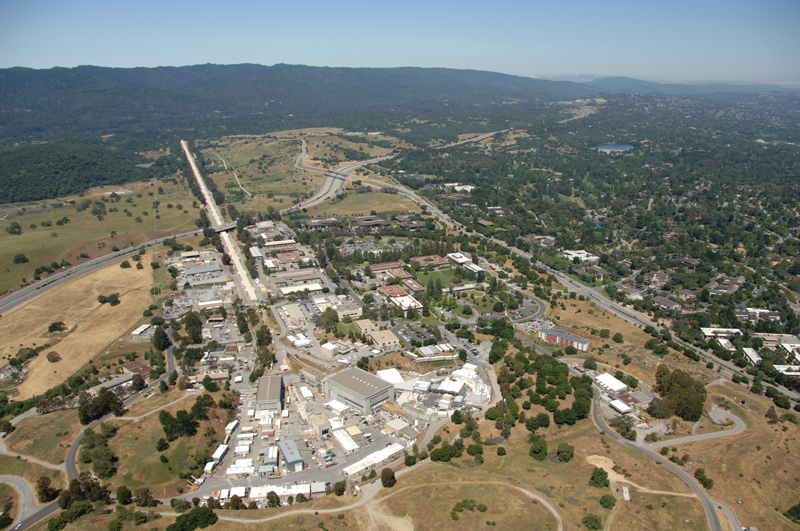SLAC Probes Building Blocks of Matter
Spring
2016
Special Feature
PhysCon 2016 Preview
SLAC Probes Building Blocks of Matter
Rachel Kaufman

Long before there was the Large Hadron Collider and the Relativistic Heavy Ion Collider, there was the Stanford Linear Accelerator.
When Stanford’s particle collider opened in 1962, it was the longest linear accelerator ever built. It still is. The particle accelerator has helped scientists make countless discoveries about the tiniest building blocks of our universe; three Nobel Prizes have been awarded for discoveries made, in part, by scientists working at SLAC.
“There’s no end to the amazing things going on here,” says Michael Peskin, a professor of theoretical physics at SLAC.
In 1957, particle accelerators at Brookhaven National Laboratory and the University of California, Berkeley, were leading the way in discoveries of new subatomic particles. Riding that wave, Stanford scientists proposed building an even more powerful collider. It would be 2 miles long and be able to accelerate electrons to 50 gigaelectronvolts, causing them to move much faster than any other accelerator of the day. It would also cost more than $100 million in 1957 dollars, making it, at the time, the most expensive nondefense research venture in US history.
Still, researchers were confident that the proposed linear accelerator would provide answers for physicists, even if the answers were to questions that hadn’t been asked yet. At one point during a congressional hearing, a senator asked one of the accelerator designers, Dr. Edward Ginzton, “Can you tell us precisely why you want to build this machine?” Dr. Ginzton replied, “Senator, if I knew the answer to that question, we would not be proposing to build this machine.”
The collider eventually got built and almost immediately began producing solid science. In 1968, scientists working at SLAC discovered quarks for the first time. Just a few years later in 1974, SLAC’s Burton Richter discovered the J/psi particle, as did another team at Brookhaven working independently. Just a year later a team led by Martin Perl discovered the tau lepton. These three discoveries would eventually lead to Nobel Prizes in Physics.
Around the same time, says Peskin, “Professor William Spicer noticed that the synchrotrons here emit X-rays at a rate which is… potentially a billion times more intense than one got from the standard equipment at the time. And so this enabled all kinds of new X-ray experiments, which were done here for the first time.” The Linac Coherent Light Source, or LCLS, reuses a third of SLAC’s old accelerator. (The other two-thirds is dedicated to the FACET project, which is an R&D project for experimental beam physics.)
Now, SLAC’s X-ray free-electron laser “has pretty much taken over the whole laboratory,” Peskin says. The LCLS, when it opened, was a billion times brighter than any other X-ray source in existence, says Alan Fry, division director of laser science and technology for the LCLS. “It’s the difference between a high-powered laser and moonlight.” The LCLS also produces extremely short pulses that last just a few femtoseconds. “This is the time scale on which stuff actually happens at the molecular and atomic scale,” Fry says. That means researchers can use the LCLS to create essentially stop-motion movies of molecules breaking apart or electrons redistributing themselves. Mike Minitti, a SLAC scientist whose “molecular movie” of 1,3-cyclohexadiene unfurling was on the cover of Physical Review Letters last summer, told the journal at the time, “This fulfills a promise of LCLS. Before your eyes, a chemical reaction is occurring that has never been seen before in this way.”
Because scientists are clamoring for time on the LCLS (SLAC runs around the clock almost every day), and because there’s even more to be done with X-ray lasers, SLAC is building the LCLS-II, which will increase the number of X-ray pulses from 120 per second to a million per second. LCLS-II is under development now but won’t open for another 5 or 6 years. When it does, researchers will be able to perform new kinds of experiments in emerging fields like quantum chemistry, structural biology, and surface physics, potentially leading to new understandings of basic matter, as well as new technologies and materials.
SLAC’s equipment is used for more than just probing the properties of tiny particles. Scientists have studied the bone chemistry of Archaeopteryx with SLAC’s synchrotron radiation lightsource and revealed hidden text written by Archimedes on a manuscript that had later been overwritten with 10th-century Greek Orthodox prayers. Other SLAC researchers are helping to develop an experiment that detects dark matter, or hunting for ways to improve rechargeable batteries, develop better antibiotics, and even improve computer hard drives.
“It’s always been an exciting place, with people coming up with crazy ideas,” Peskin says
Fry agrees. “This is really only the beginning of the story of these machines and what they’re going to be able to do and the science they’re going to be able to produce.”
